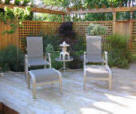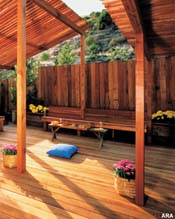|
Redwood Fences from Practical to Elegant
(ARA) - When you build a redwood fence, it's almost always because of a specific need. You need to keep the dog in the yard. You need a boundary between your house and the street. You need a tad more privacy. How you build your fence is a matter of taste. Redwood fences range in design from the practical to the elegant. Redwood is the material of choice for these fences because it's durable, it looks good and it resists warping, splitting and checking. Redwood's beauty and long-lasting qualities are built in and natural, unlike synthetic and treated materials. Whether they're practical or more elegant, most fences are variations on a simple structure involving posts, rails and fence boards. The post and rail support structure is made of standard dimension lumber, while fence boards of different shapes and sizes give a fence its individual style. There are many standard designs to choose from. Solid board fences provide maximum privacy. Alternating board and board designs are known as "good neighbor" fences because they look the same from either side. Lacy lattice screens are ideal for climbing plants. Classic picket fences make attractive boundary markers. You'll find lots of great sources for fence design ideas. First of all, you can drive around your neighborhood. Unlike decks, which are usually hidden in back yards, you can see fences from the street. You can find fence plans in books at the library or your local home center, and there are often articles in how-to magazines. The California Redwood Association offers a booklet on fence design called "Redwood Fences for All Reasons." In addition to the design, the materials you choose are important and help determine whether your fence is in the practical category or the elegant category. Most utilitarian redwood fences are built with knot-textured "garden grades" of redwood. These rugged grades are economical and provide the best combination of performance and value. More elegant fences use better grades of redwood. Some high-style fences make great use of other materials for design accents. For example, ceramic ornaments, oxidized copper or other metal elements can give your fence a one-of-a-kind distinction. It is important to use non-corrosive nails and hardware to avoid unsightly stains. Stainless steel, aluminum or top quality hot-dipped galvanized hardware is required. When you complete your project, you might decide to use a water repellent finish to protect the redwood from rain and sun. However, redwood is one of the few woods that perform well without a finish. So it's your choice -- apply a finish or leave the fence to weather naturally. If you want an elegant fence that's a work of art in your yard, you may want to contact a pro to design and build it for you. If you're interested in a practical no-nonsense fence and want to save money, you may want to build it yourself. In either case, here are some tips on fence construction. Setting posts is the most critical part of any fence job. Posts must be straight and evenly spaced, which requires patience and lots of measuring. Construction Heart grade redwood is the right choice for fence posts because it resists decay and insects. Posts are usually placed 8 feet apart -- the standard length of fence rails. Mark locations with stakes. Set corner posts first. String a line between corner posts to mark the fence line and then align the inside posts. Dig post holes about 10 inches in diameter with a post hole digger. For a 5- or 6-foot fence, post holes should be at least 2 feet deep. A 3-foot hole is needed for an 8-foot fence. To ensure drainage, the bottom of post holes should be lined with gravel, stones or concrete debris. For the strongest fence, set posts in a concrete collar, making certain that the bottom is open to permit drainage. When setting posts, use a carpenter's level to ensure that posts are plumb. Check repeatedly to make sure the post is both perpendicular and aligned with the other fence posts. For most designs, either two or three horizontal rails run between the posts, depending on the fence height. Upper rails should rest on the tops of the posts for support. Bottom rails can be toe-nailed into place, but the preferred method is to place a block underneath the joint for extra support. You can also use metal hardware such as "L" brackets to secure rails to posts. Nailing the fence boards in place is the easiest and most satisfying part of building a fence. Economical Construction Common or Merchantable grade redwood boards about an inch thick and 4 to 10 inches in width are popular for utilitarian fences. Near the ends of the board, pre-drill holes before nailing to avoid splitting. For fence boards of widths 4 inches or less, use one nail per bearing. For wider fence boards, use two nails. Whether you want a practical fence or an elegant fence, you'll find that it's a satisfying and rewarding project. Like any construction project, it's best to plan ahead, use quality materials and give yourself plenty of time to do the job right. For more help, send $2.50 for "Fences for All Reasons," a 16-page color booklet that gives great ideas with over 30 photos. It also includes construction drawings for dozens of fence designs and step-by-step building instructions. Write to California Redwood Association, Department FNA-06, 405 Enfrente Drive, Suite 200, Novato, California 94949. For other project plans and redwood information, check out the Web site at www.calredwood.org. Courtesy of ARA Content For information on adding finishing touches to your fence or deck, please read this article on adding caps to deck railings posts.
|
|
|||||||||||||
|
|||||||||||||||
|
|
|||||||||||||||



